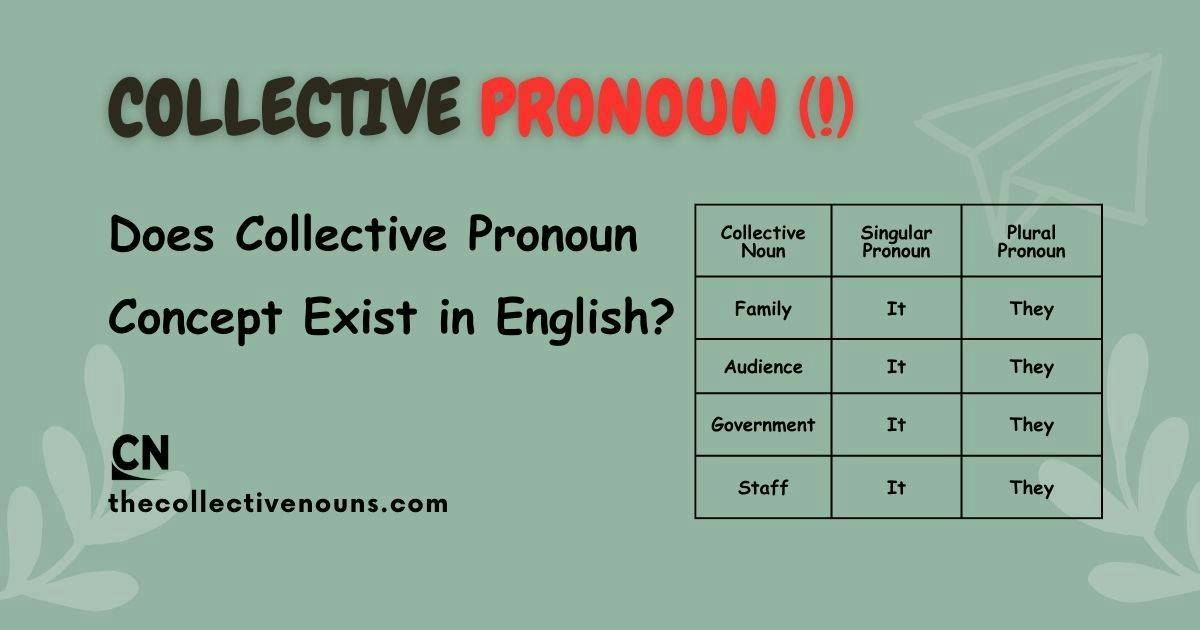The term “collective pronoun” isn’t a formally recognized category in English grammar in the same way that personal pronouns (e.g., “I,” “you,” “he,” “she,” “they”) or possessive pronouns (e.g., “mine,” “yours,” “theirs”) are.
However, the concept might arise in discussions about how pronouns interact with collective nouns or in specific linguistic contexts.
If by “collective pronouns” you mean pronouns that refer to a group as a single entity or as individuals within a group, this ties into how pronouns work with collective nouns. Let’s explore that further.
Does the Collective Pronoun Concept Exist in English?
Not explicitly as a distinct grammatical category. English doesn’t have a specific set of pronouns labeled “collective pronouns.”
Instead, English uses existing pronouns (like “it” or “they”) to refer to collective nouns, depending on whether the group is treated as a singular entity or a collection of individuals. This flexibility is a feature of English grammar and relates directly to collective nouns.
What Are Collective Nouns?
A collective noun is a word that refers to a group of people, animals, or things as a single unit. Examples include:
- “Team”
- “Family”
- “Crowd”
- “Flock”
- “Committee”
In English, collective nouns can be tricky because they can take either singular or plural pronouns and verbs, depending on the intended meaning:
- Singular emphasis (the group as a unit): “The team is winning.” (Here, “team” is treated as one entity.)
- Plural emphasis (the individuals within the group): “The team are arguing among themselves.” (Here, “team” refers to the individual members.)
Relation Between Collective Nouns and Pronouns
The relationship between collective nouns and pronouns lies in how pronouns replace or refer back to these nouns. In English, the choice of pronoun (“it” vs. “they”) reflects whether the collective noun is being treated as a singular unit or as a plural group of individuals:
-
“It” is used when the collective noun is singular and emphasizes the group as a whole:
- “The committee made its decision.” (“Committee” is one entity, so “its” is singular.)
-
“They” is used when the collective noun is pluralized in meaning, focusing on the individuals:
- “The committee couldn’t agree, so they postponed the meeting.” (“Committee” refers to the members acting individually, so “they” is plural.)
This adaptability is why some might informally describe pronouns like “they” as functioning “collectively” in certain contexts, though English grammar doesn’t officially designate them as “collective pronouns.”
Key Points
- No Official “Collective Pronouns”: English doesn’t have a separate class of pronouns called “collective pronouns.” The term might be a confusion with how pronouns interact with collective nouns.
- Pronouns and Collective Nouns: The pronouns “it” (singular) and “they” (plural) are used with collective nouns, depending on whether the group is seen as a unit or as individuals.
- Context Matters: The choice between singular and plural pronouns reflects meaning and is often a stylistic or regional preference (e.g., British English tends to favor plural verbs/pronouns with collective nouns more than American English).
Example for Clarity
- Collective noun: “The band”
- Singular: “The band is playing its new song.” (“Band” as a unit, “its” as the pronoun.)
- Plural: “The band are tuning their instruments.” (“Band” as individual members, “their” as the pronoun.)
So, while there’s no standalone “collective pronoun” concept in English, the way pronouns like “it” and “they” interact with collective nouns effectively bridges the idea you might be asking about.
